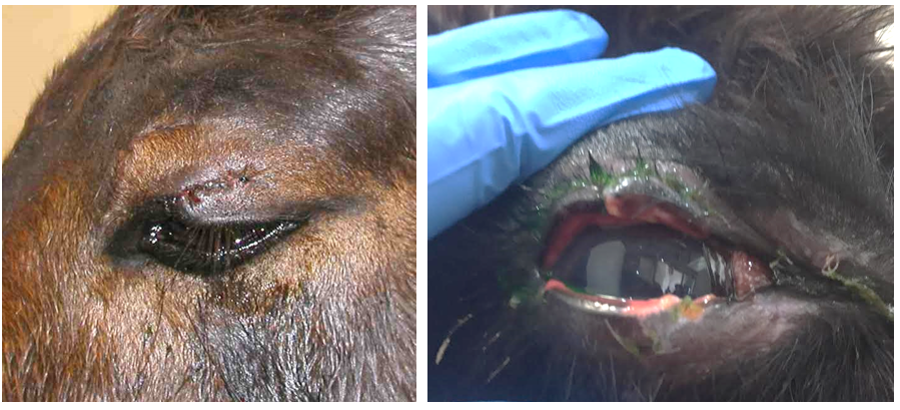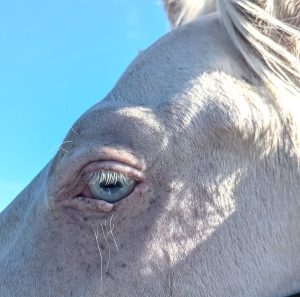Eye surgery
Eyelid lacerations
Eyelid lacerations require special care but not specialists. Horses like to injure their eyelids quite frequently. Horse eyelid lacerations are often referred to as “bucket handle tears” as horse injure the lids on their water or feed buckets when they jerk their heads up too quickly. The exposed eyes of camelids make eyelid lacerations common in those species, too.

Before eyelid repair, it is important to check the cornea for damage. Corneal ulcers can occur due to the primary trauma or due to exposure after the trauma. Corneal abscesses are also possible with the initial trauma. Perform a fluorescein stain and ophthalmoscopic exam.
Eyelid lacerations may be repaired using standing sedation or under general anesthesia. Standing sedation is used whenever possible to avoid the risks of general anesthesia. For standing sedation, personal preference often plays a role with many drug options available. Go light on the butorphanol as some horses will develop twitches with narcotics. These can be very annoying. Some surgeons prefer to avoid butorphanol. An iv infusion of detomidine can also maintain stable sedation.
Local blocks can help with both standing sedation or GA.

Key points
- Use betadine solution and saline; not scrub or alcohol. Betadine scrub, chlorhexidine and alcohol can all damage the cornea.
- Do NOT trim off skin flaps unless the skin is obviously dead (cold and leathery). The head has excellent blood supply and most lacerations will heal well. If the eyelid margin cannot be reconstructed, exposure keratitis is very likely due to lack of complete eyelid closure.

- Sutures rubbing on the eye can create ulcers. Keep knots away from the cornea and use very soft suture.
- When closing the skin, close the eyelid margin first to ensure optimum alignment. A figure 8 pattern minimizes the suture poking into the cornea by moving the knots back from the eyelid margin. This pattern needs to be symmetric to create a even lid margin. It may take 2-3 attempts but the time spent is worthwhile. After the margin is apposed, the remainder of the laceration can be closed with simple interrupted or cruciate sutures.
Preoperative antibiotics and NSAIDs are recommended. Postoperative antibiotics are usually not required. NSAIDs can help minimize swelling and decrease the risk of dehiscence. If animals start to rub at the eye, an eye cup or head bandage should be used to protect the wound. Sutures should be removed in 10-14 days even if absorbable. As the sutures dissolve, parts may start to rub the cornea. Unless the cornea has been damaged, we don’t try to treat the eye topically. The difficulty in getting medications into the eye outweighs any benefit and may well cause damage to the eyelid repair.
Examples- Interactive videos
Key Takeaways
Eyelid lacerations should be repaired primarily. They do poorly if left for second intention healing.
Don’t use betadine scrub or chlorhexidine scrub near the eye, unless the eye is being removed.
Don’t debride or cut off pieces of eyelids.
Use soft small gauge suture material on a cutting needle. Remove in 10-14 days.
Use a pattern that keeps suture away from the cornea.
Resources
Ophthalmic emergencies in the field, 2021 VCNA Vol 37; pp 441-460
Equine eyelid disease, 2005 CTEP pg 96-97 – good resource for other eyelid surgeries (all species) and periocular sarcoids
Butorphanol twitches – video

